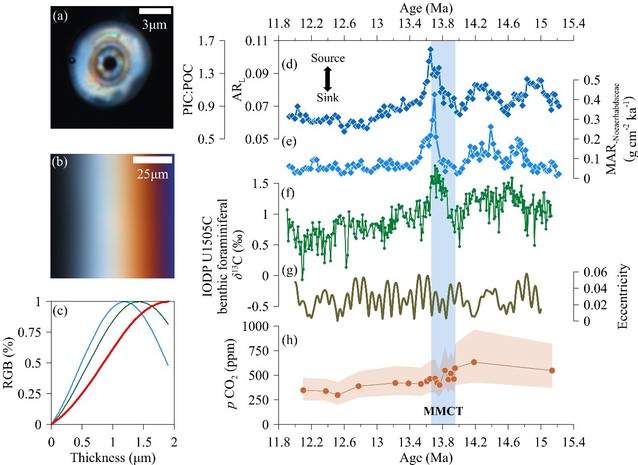Lishun Sun1 , Xiaobo Jin1 , Xiang Su2 , Chuanlian Liu1,*
1 State Key Laboratory of Marine Geology, Tongji University, Shanghai 200092, China
2 Key Laboratory of Ocean and Marginal Sea Geology, South China Sea Institute of Oceanology, Chinese Academy of Sciences, Guangzhou 510301, China
* Corresponding author.
Email: liucl@tongji.edu.cn
Abstract
Coccolithophores are a kind of marine calcifying algae, contributing to the ocean biological and carbonate counter pumps. Quantifying the relative ratio of particular inorganic and organic carbon (PIC:POC) of coccolithophores is significant for understanding the ocean carbon cycle. Coccolith mass accumulation rate (MAR) in marine sediments can reflect the coccolithophore ability for producing inorganic carbon, indicating the strength of coccolith-based carbonate counter pump in the past. The morphology of individual coccolith provides information of cellular PIC:POC production in the euphotic zone. Here, a novel method is developed to estimate coccolithophore PIC:POC based on the lateral aspect ratio of detached coccoliths in marine sediments at IODP Site U1505C in the South China Sea during the Mid-Miocene. We show that coccolithophore PIC:POC and coccolith MAR exhibit synchronous variations with benthic foraminiferal carbon isotope (δ13C) at the same site, with high coccolithophore PIC:POC and coccolith MAR coupling with positive benthic δ13C. We propose that a positive benthic δ13C may link to reduced terrestrial nutrient input, which leads to an oligotrophic ocean and diminished diatom productivity. This would create a niche for coccolithophores with high PIC:POC and enhanced coccolith-based carbonate counter pump.

Figure. Coccolith morphological parameters compared with benthic foraminifer δ13C at IODP Site U1505C in the SCS. (a) Noelaerhabdaceae coccolith morphological measurement; (b) Image of a calcite wedge under circular polarizing microscope; (c) The relationship between calcite wedge thickness and RGBs; (d) Noelaerhabdaceae coccolith lateral aspect ratio (ARL), larger (smaller) ARL indicates higher (lower) coccolithophore PIC:POC, as a potential CO2 source (sink); (e)Mass accumulation of Noelaerhabdaceae coccoliths.(f) Benthic foraminiferal δ13C at Site U1505C. (g) Earth eccentricity ;(h) The planktonic boron isotope-based atmospheric pCO2. The shading indicates a 95% confidence interval of uncertainty.
Full Article: https://doi.org/10.1016/j.scib.2024.11.052

